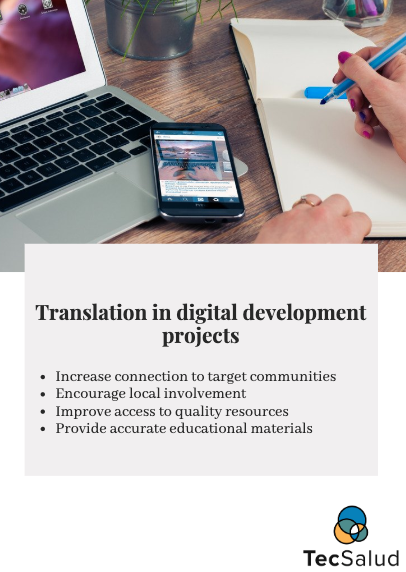Spanish is the official language of 20 countries in the world (plus Ecuatorial Guinea and Puerto Rico). If you add countries that have a high percentage of Spanish speakers, such as Aruba (80%), Belize (52%), or the United States (18%), plus all of the places where Spanish is spoken in some capacity, you’re talking about more than 577 million speakers worldwide.

The USA contains the 5th largest population of native Spanish speakers. If you include speakers with some competence of the language, there are roughly 58 million speakers, jumping it up to #2. Yes, that means there are more Spanish speakers in the USA than all of Spain.
The United States is a leader in the health, technology and research sectors, as well as one of the most significant players (and funders) in the world of international development. Despite the language statistics, much of what is published about these areas is still mainly available in English.
The translation and adaptation of resources to Spanish will surely reduce inequality by increasing availability of information. This is particularly important in international (and domestic) development, as we see many English language case studies, online resources and publications citing non-English speaking field sites.

Access to quality information increases the opportunity for education
Access to information online is critical to the education of vulnerable communities. The Latin America and the Caribbean region contains an estimated 10% of internet users in the world, while North America just 7.2%.
As more Spanish speakers come online, they must be able to find accurate and properly translated information. They may search for health information, nearby services, or more specific information regarding technical documentation, research findings or related. While it has been found that publications do exist in Spanish and other widely spoken languages, they are not easily searchable and/or simply left out of places where they should be found.
Communicating in the local language builds program trust
Having the resources translated in the local language and team members who are native speakers can greatly strengthen the relationship between the program and its target population.
If arriving on site, prepare to deliver materials in the local language rather than planning for it post-implementation. An up-front investment in translation combined with a commitment to hire (and pay equally!) local teams will set the program apart.
Local culture is best understood in local language
Sharing common language will increase knowledge of culture and local needs. People impacted by your programs will appreciate the effort made to prioritize quality resources, plans and staff who can speak clearly and be understood. Language is an essential part of the identity of a community. Marginalized areas may not feel as open to sharing their culture if your team does not include native language speakers.
Poorly translated information may create more distance between the culture you’re aiming to understand and your team.
Consider the regional potential
“Language is a factor that contributes significantly to the knowledge exchange between regions”
Development professionals default to English (vs. French or Spanish) to first publish findings, perhaps forgetting the opportunity for regional learning and cross-border collaboration. Latin America has incredible potential for regional programs which can only be strengthened by a collective commitment to Spanish-language publication.
Communicating accurately and fully can make a world of difference
Everything is reduced in clear communication. Approaching translation as a language-to-other-language process often leaves room for (sometimes very significant) error. Commitment to translation must be a commitment to accurate, professional, error-free delivery of materials in multiple languages.
As digital development professionals, if we are committing to using technology for good and for impact, then we must do so in more than just English. We often cite bringing technology to the remotest places, compiling robust lit reviews and compendia of lessons learned and case studies. How many cite, say, Guatemala, but are only available and searchable in English? A quick internet search yields quite a few interesting and compelling resources about NGO and development initiatives that Spanish speakers could greatly benefit from accessing online.
It is clear that if we want to contribute to closing the digital divide we must prioritize the digital language divide and make our learnings available in more languages. It is not enough to say that English is the language of the internet. We can do better than that.

If you’re considering offering your resources, research, or other communications in Spanish, we can help. Contact Us for Info.





